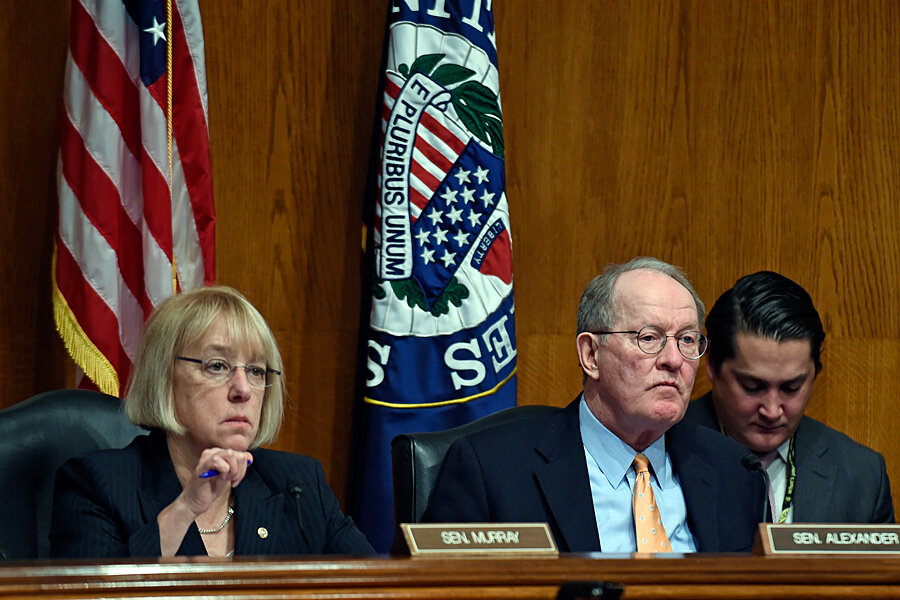No Child Left Behind 101: where lawmakers agree, disagree
Loading...
Congress is working toward a long-overdue rewrite of the high-profile and often controversial federal K-12 education law known as No Child Left Behind (NCLB). Here’s what to keep in mind as the House takes up floor debate on a mostly GOP version Wednesday and as Senate committee leaders work toward crafting a bipartisan proposal.
What is NCLB?
NCLB is the current name for the 1965 Elementary and Secondary Education Act (ESEA) and is largely known for its Title I grants to support low-income students. NCLB had bipartisan support and took effect in 2002, using annual testing to hold schools accountable for academic performance and for narrowing achievement gaps. It required all students to reach proficiency by 2014, but most schools haven’t been able to reach that target.
Why are lawmakers focused on it now?
NCLB has been due for reauthorization by Congress since 2007. There’s bipartisan agreement that the law is broken, but agreeing on how to fix it has proved difficult so far. Many states have waivers from the US Department of Education to pursue alternative systems of accountability.
Now that Republicans control both the House and Senate, however, efforts to push through a major overhaul are again under way. Many current members of Congress have either experienced the dysfunction of NCLB as governors or state lawmakers, or are hearing complaints from constituents, so “there’s a lot of pressure from a lot of different directions to finally get this done,” says Patrick McGuinn, a political science professor at Drew University in Madison, N.J.
Which aspects of the law present the best opportunity for bipartisanship?
Although debates about testing are to be expected, maintaining annual testing requirements is likely to find bipartisan support, education policy experts say. Even with pressure from anti-testing groups and some conservative Republicans to get rid of those federal requirements, most Republicans and Democrats see value in the tests as a way to measure progress and not lose sight of whether historically lower-performing groups are catching up.
It’s also likely that many Democrats and Republicans will agree not to pressure states to tie those test results to teacher evaluations. The Obama administration’s efforts to reward states for such links have been controversial.
What are the biggest areas of disagreement?
Accountability, for one. There’s huge debate about what role the federal government should play in holding schools accountable for student performance. The bill that passed out of the House Education and the Workforce Committee Feb. 11 (with no Democratic support) would let states decide their own accountability systems. Known as the Student Success Act, it’s generating pushback from civil rights groups and many Democrats, who say that ESEA must include some requirements for states to ensure that students from all backgrounds are being equitably prepared for college or careers.
Under NCLB, schools that aren’t meeting accountability goals have to offer various options to students and adopt turnaround plans. The new version will probably give a great deal of flexibility to states, but not necessarily as much as the House bill offers.
Another point of contention: how funds are distributed. The House bill offers “portability” for Title I dollars – meaning they would follow a low-income student to any public school he or she attends, including a charter school (which typically has autonomy rather than having to follow district rules). Some Republicans want the money to flow even to private schools – akin to vouchers – but House committee leaders avoided that, knowing it would have been “a bridge too far,” says Michael McShane, a research fellow in education policy studies at the American Enterprise Institute in Washington.
Republicans also favor consolidating dozens of federal programs and offering block grants to states to cover, as they see fit, teacher professional development and after-school programs. The House bill would also allow states and localities to reduce their own education funding as federal dollars come in, ditching the current “maintenance of effort” requirement.
Democratic lawmakers and the White House have slammed these GOP proposals as an abdication of the federal role to channel aid to the neediest students.
Other issues that will require compromise include how much funding the law should receive overall and whether early-childhood education provisions should be added.
What are the prospects for getting legislation passed and signed this year?
Lawmakers are moving fast in the hope of finishing up before the fall, when presidential election politics will kick into high gear, and several education policy analysts say they expect Congress to succeed.
With a strong background in education policy and respect on both sides of the aisle, Sen. Lamar Alexander (R) of Tennessee is “ideally situated to be the person leading this reauthorization effort,” Professor McGuinn says.
Senator Alexander is chairman of the Health, Education, Labor and Pensions Committee. After initially releasing a partisan draft bill, he recently started negotiating with Sen. Patty Murray of Washington, the top Democrat on the committee. By some accounts, they may be able to hammer out a bipartisan proposal before the end of March.
If the House and Senate manage to reconcile their views and pass a bill along to President Obama, several analysts say they think he’d be inclined to sign it. He hasn’t yet drawn a line in the sand on any issues.
Whatever the particulars, the country appears to be heading toward a new education law that represents “a pretty significant shrinking of the federal footprint ... like from a Size 12 EEE to a Size 5,” says Maria Ferguson, executive director of the Center on Education Policy in Washington.








